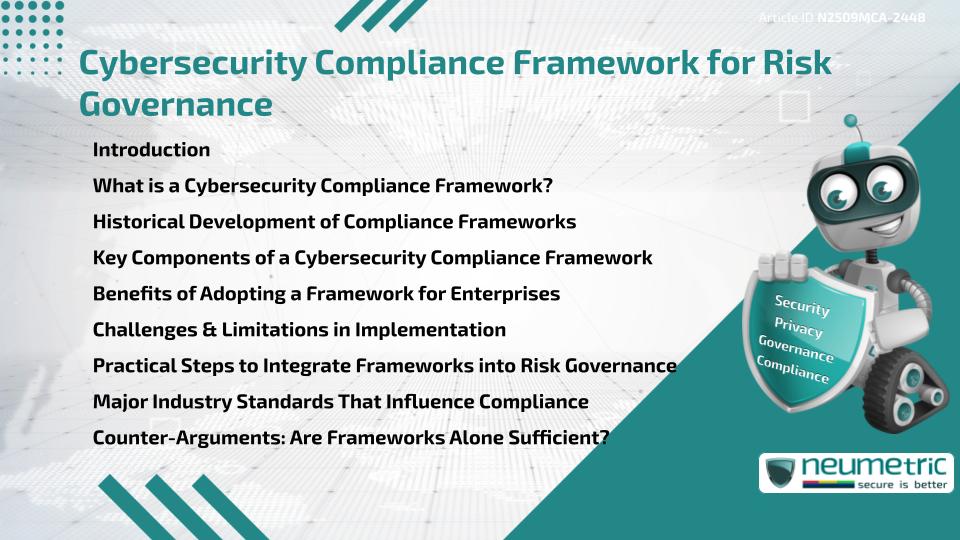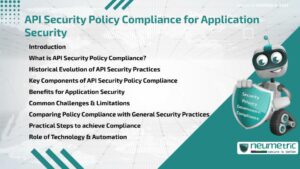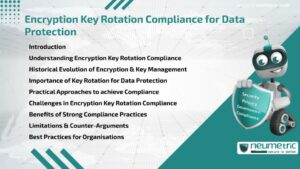Table of Contents
ToggleIntroduction
A Cybersecurity Compliance Framework is a structured model that guides enterprises in aligning Security Measures with Regulatory requirements & Risk Governance principles. It provides a blueprint for assessing Risks, implementing Controls & ensuring Accountability. By adopting such a Framework, enterprises can better manage Threats, maintain Trust & demonstrate Compliance. This article examines the meaning of a Cybersecurity Compliance Framework, its history, essential components, benefits, challenges & its role in effective Risk Governance.
What is a Cybersecurity Compliance Framework?
A Cybersecurity Compliance Framework is a standardised set of Policies, Procedures & Controls designed to help Organisations manage Cybersecurity Risks & comply with regulations. It serves as a roadmap for integrating security into Risk Governance, much like a building code ensures safe construction.
Enterprises use these frameworks to measure their Security maturity, identify Gaps & document Compliance. For example, a Financial institution may use a Framework to demonstrate adherence to Data Protection laws while also improving resilience against cyberattacks.
Historical Development of Compliance Frameworks
The origins of Cybersecurity frameworks can be traced back to early Regulatory efforts in the 1990s, when businesses began digitising Sensitive Information. The Health Insurance Portability & Accountability Act [HIPAA] in the United States & the Gramm-Leach-Bliley Act [GLBA] marked milestones in formalising security practices.
Later, the NIST Cybersecurity Framework & ISO 27001 provided Global Standards, offering enterprises structured models to integrate Cybersecurity into Governance. These frameworks continue to evolve alongside Regulatory landscapes & emerging Threats.
Key Components of a Cybersecurity Compliance Framework
An effective Cybersecurity Compliance Framework typically includes:
- Risk Assessment: Identifying Vulnerabilities & Threats across enterprise systems.
- Control Implementation: Establishing Policies for Access, Encryption & Monitoring.
- Incident Response: Defining procedures for detecting, reporting & mitigating Breaches.
- Audit & Monitoring: Continuous evaluation of Security Performance & Compliance.
- Training & Awareness: Educating Employees on responsibilities & Best Practices.
These components ensure that enterprises cover both technical & organisational aspects of Cybersecurity.
Benefits of Adopting a Framework for Enterprises
Enterprises gain several advantages from adopting a Cybersecurity Compliance Framework:
- Regulatory Assurance: Demonstrates adherence to Industry & Government regulations.
- Risk Reduction: Identifies & mitigates Security Gaps before they escalate.
- Operational Consistency: Standardises practices across departments & Vendors.
- Stakeholder Confidence: Strengthens trust with Customers, Partners & Regulators.
A well-implemented Framework also improves Audit readiness, reducing the burden of external reviews.
Challenges & Limitations in Implementation
While frameworks are powerful tools, they are not without limitations. Implementing them can be resource-intensive, especially for smaller enterprises. A one-size-fits-all approach may not account for industry-specific Risks. Moreover, frameworks can sometimes encourage a “checklist mentality”, where organisations focus on Compliance at the expense of genuine security improvements.
Practical Steps to Integrate Frameworks into Risk Governance
Enterprises can embed frameworks into Governance by:
- Mapping Framework requirements to existing processes.
- Assigning ownership to leadership teams for Accountability.
- Leveraging automation to streamline monitoring & reporting.
- Conducting regular internal Audits & Third Party reviews.
- Updating Policies to adapt to evolving Threats & Regulations.
By treating Compliance as an ongoing practice rather than a one-time task, enterprises strengthen both Governance & resilience.
Major Industry Standards That Influence Compliance
Several well-recognised standards shape the foundation of Cybersecurity frameworks:
- NIST Cybersecurity Framework for U.S.-based Risk Management.
- ISO 27001 for global Information Security management.
- HIPAA for Healthcare Data Protection.
- PCI DSS for payment card industry security.
These standards provide enterprises with adaptable templates for building customised Cybersecurity Compliance frameworks.
Counter-Arguments: Are Frameworks Alone Sufficient?
Some critics argue that frameworks can create a false sense of security if used in isolation. Compliance does not automatically equate to resilience. Cyber Threats evolve rapidly, while frameworks often lag behind. Enterprises must supplement frameworks with proactive measures such as Penetration Testing, Threat Intelligence & adaptive Risk strategies. Thus, a Cybersecurity Compliance Framework should be treated as a foundation, not a final solution.
Conclusion
A Cybersecurity Compliance Framework is indispensable for modern enterprises. It strengthens Governance, ensures Regulatory alignment & reduces Risk exposure. While not without challenges, it provides a structured path for integrating security into enterprise operations.
Takeaways
- A Cybersecurity Compliance Framework standardises Security & Compliance practices.
- Frameworks like NIST & ISO 27001 underpin effective Governance.
- They enhance Trust, reduce Risks & improve Audit readiness.
- Enterprises must avoid Checklist thinking & pursue Continuous Improvement.
FAQ
What is the purpose of a Cybersecurity Compliance Framework?
Its purpose is to guide enterprises in managing Risks & demonstrating Compliance with Security & Regulatory Standards.
How does a Framework support Risk Governance?
It integrates security practices into Governance by assigning Accountability, standardising Controls & aligning operations with regulations.
Do all enterprises need the same Framework?
No. While Core Principles are universal, enterprises should adapt frameworks to their size, industry & Regulatory environment.
What are examples of Cybersecurity Compliance frameworks?
Examples include NIST Cybersecurity Framework, ISO 27001, HIPAA & PCI DSS.
How often should enterprises review their Framework Compliance?
Enterprises should review Compliance annually & whenever significant Technological or Regulatory changes occur.
What are the limitations of Cybersecurity Compliance frameworks?
They may encourage a checklist mindset, require significant resources & lag behind evolving Threats.
Can a Framework prevent all cyberattacks?
No. Frameworks reduce Risks but cannot eliminate them. Additional proactive Security Measures remain essential.
Need help for Security, Privacy, Governance & VAPT?
Neumetric provides organisations the necessary help to achieve their Cybersecurity, Compliance, Governance, Privacy, Certifications & Pentesting needs.
Organisations & Businesses, specifically those which provide SaaS & AI Solutions in the Fintech, BFSI & other regulated sectors, usually need a Cybersecurity Partner for meeting & maintaining the ongoing Security & Privacy needs & requirements of their Enterprise Clients & Privacy conscious Customers.
SOC 2, ISO 27001, ISO 42001, NIST, HIPAA, HECVAT, EU GDPR are some of the Frameworks that are served by Fusion – a SaaS, multimodular, multitenant, centralised, automated, Cybersecurity & Compliance Management system.
Neumetric also provides Expert Services for technical security which covers VAPT for Web Applications, APIs, iOS & Android Mobile Apps, Security Testing for AWS & other Cloud Environments & Cloud Infrastructure & other similar scopes.
Reach out to us by Email or filling out the Contact Form…





